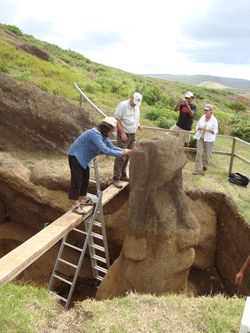
(Courtesy Jo Anne Van Tilburg)
That archaeology and human heritage are present everywhere across the
globe is amply demonstrated by the case of Easter Island (Rapa Nui). One of the
most remote places on earth, this tiny island in the Pacific is home to the famed
monolithic statues called moai. The colossal moai have near-iconic status as testaments to
humanity's early technological achievements.
Yet not even so remote a location can protect an archaeological monument from damage
and so, in 2008, the Archaeological Institute of America proudly awarded its second-ever
Site Preservation grant to Jo Anne Van Tilburg of the University of California, Los Angeles'
Cotsen Institute of Archaeology for her conservation work on the moai of Easter Island.
A 30-year veteran of Easter Island archaeology, and director of the Easter Island Statue
Project, Van Tilburg is currently working to arrest the deterioration suffered by the statues
as a result of weathering, vandalism, mass tourism, and encroaching development.
This spring I visited Easter Island in order to see Van Tilburg and her team in action.
Working with conservators such as Mónica Bahamondez,
director of the Chilean National Center for Conservation
and Restoration, and geologist Christian Fischer
of UCLA, Van Tilburg has overseen the cleaning, lichen
removal, and application of protective chemicals in an
effort to save the statues.
During my week's visit, I also met a number of local
professionals who have been trained by Van Tilburg and
others. Living full-time on the island, they work as archaeologists,
archaeological draftsmen, preservationists, and
conservators. They also play a vital role in educating
their fellow islanders about the importance of the moai.
Without such local support and ongoing education, most
preservation efforts will ultimately fail.
Among Van Tilburg's principal collaborators is the talented archaeologist Cristián Arévalo
Pakarati. In addition to codirecting the Easter Island Statue Project with Van Tilburg,
Arévalo Pakarati is an artist and graphic designer. He designed a gallery several years ago
with Johannes Van Tilburg, Jo Anne Van Tilburg's architect husband, and built it with his
own hands. While serving as project headquarters, the attractive gallery earns a modest
income by hosting exhibitions by local artists and artisans celebrating the island's archaeology.
Along with community involvement, economic development can be critical to the success
of preservation initiatives.
The AIA's Site Preservation Program, founded in 2007, has so far awarded funding to 19
projects around the globe. The Program funds small but significant projects that typically
include education and public outreach and also emphasize best practices in conservation.
Worldwide, the threats to archaeological monuments show no sign of abating. Support fom
the AIA will help ensure that irreplaceable monuments such as the moai continue to inspire—and educate—future generations. For more information, visit www.archaeological.org/sitepreservation.
Elizabeth Bartman is the president of the Archaeological Institute of America.
« President's Letter M/J 2012

